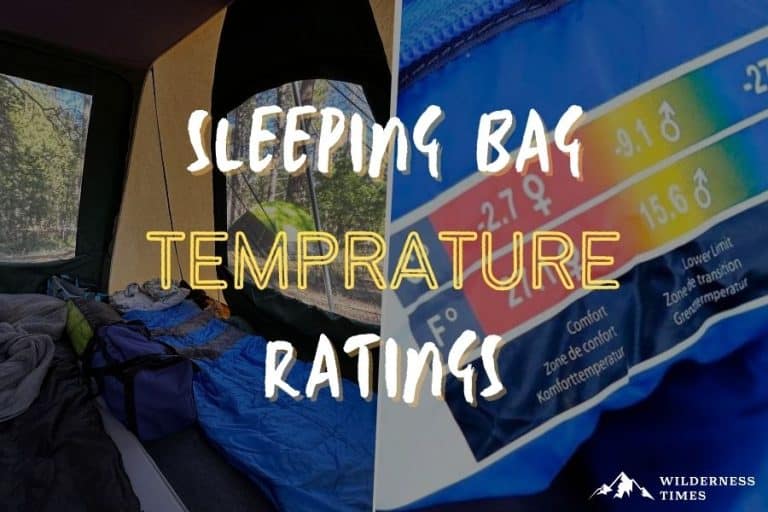It’s important to know what type of temperatures your sleeping bag can handle when you’re out on the trail – especially in cold weather conditions.
But to know which sleeping bag is best for you, you need to understand how sleeping bag temperature ratings work.
In this article, we’ll discuss those systems and why they’re important to look out for when picking your sleeping bag.
Table of Contents
ToggleHow Do Sleeping Bag Temperature Ratings Work?
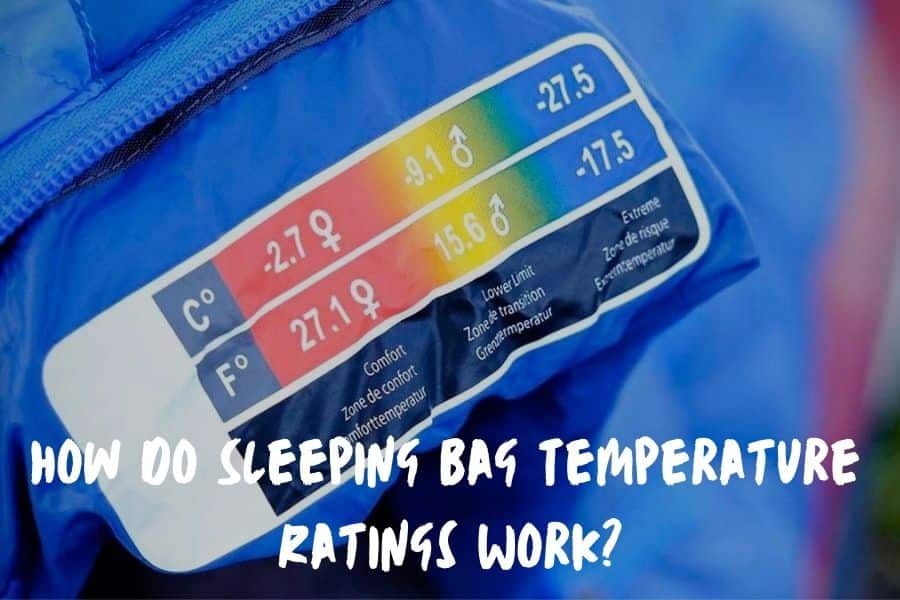
Before the early 2000s, the criteria used for sleeping bag temperature testing varied widely.
Because of this, sleeping bag warmth capacities and ratings would also vary from brand-to-brand.
To help prevent customer confusion, several sleeping bag manufacturers came together to standardize sleeping bag temperature rating systems and tests.
The European Standard (EN) was created in 2005.
After updating their testing protocols, the International Organization of Standardization (ISO) was created.
While these systems are essentially the same, the ISO serves as the updated version of standard temperature ratings.
These ratings are given via temperature ranges. Using a range to describe sleeping bag temperature ratings accommodates variables among users.
The temperature ranges are then used to determine the “season system”. This is the label most customers recognize.
It ultimately helps customers determine which sleeping bag they should buy for the conditions they’re adventuring in.
An Overview Of The Temperature Rating Systems
In general, the season system will help you choose the overall warmth category of your bag. The EN/ISO will help you tailor that category to your personal needs.
Therefore, you’ll use a combination of these rating systems when finding the right bag for you.
For example, my bag is a 3-Season Comfort bag, but that might not suit your needs.
Check out the table below for an overview of each rating system:
RATING SYSTEM | DESCRIPTION |
Season |
|
European Standard (EN) |
|
International Organization of Standardization (ISO) |
|
Season Categories
Sometimes, you’ll see sleeping bags divided into “seasons” rather than EN/ISO distinctions to determine how warm they’ll keep you.
These categories range from 1-5 Season ratings. Yes, we know there are only 4 seasons!
Check out the table below to see what temperature ranges each season ratings sleeping bags fall into:
SEASON RATING | TEMPERATURES | IDEAL CONDITIONS |
1-Season | 5°C+ / 40°F+ | Warm summer campouts |
2-Season | 0 to 5° C / 32 to 40°F | Cooler summer or spring campouts |
3-Season | -5 to 0°C / 23 to 32°F | Colder campouts (no frost), although many campers use 3-season bags year-round |
4-Season | -10°C / 14°F | Colder campouts with frost |
5-Season | -40 to -10°C / 14 to -40° F | Mountain expeditions with extremely cold conditions |
While each type of season category can have an individual use, many campers opt to get a 3-season bag.
It will keep them warm in most scenarios, has the most multipurpose use, and will provide the best warmth-to-weight ratio.
As you go up in seasons from there, the bags require more weight to keep you warm.
For example, 5-season bags are only used for mountain expeditions because carrying the extra weight is worth the warmth.
While each type of season category can have an individual use, many campers opt to get a 3-season bag.
It will keep them warm in most scenarios, has the most multipurpose use, and will provide the best warmth-to-weight ratio.
As you go up in seasons from there, the bags require more weight to keep you warm.
For example, 5-season bags are only used for mountain expeditions because carrying the extra weight is worth the warmth.
European Standard (EN)
EN RATING | DESCRIPTION |
Upper Limit | The highest temperature at which a standard adult male can sleep comfortably (without excess sweating). |
Comfort | The highest temperature at which a standard adult female can sleep comfortably. |
Lower Limit | The lowest temperature at which a standard adult male can sleep comfortably. |
Extreme | The survival rating for standard adult females, reserved only for potentially hypothermic conditions. |
Based on EN 13537.
The European Standard (EN) was the first of the two rating systems created to standardize temperature ratings.
There are four categories of EN ratings: Upper Limit, Comfort, Lower Limit, and Extreme.
The most frequently used category is EN Comfort. It generally refers to the maintained temperature needed to keep the average woman warm while sleeping.
The second most frequent EN category is EN Lower Limit, based on the temperature needed to keep the average man warm while sleeping.
International Organization Of Standardization (ISO)
ISO RATING | DESCRIPTION |
Comfort | Lower limit of comfort range for a cold sleeper in a relaxed position. |
Limit | Lower limit for a warm sleeper in a curled body position. |
Extreme | Lowest temperature: the risk of hypothermia is possible |
Based on ISO 23537.
ISO’s most commonly used categories are Comfort and Limit.
Comfort and Limit follow the same temperature distinctions as the EN system.
Comfort is the temperature needed to keep the average woman warm, and Limit is the same for the average man.
We’ll discuss why these category distinctions are made and who else falls into them further down in the article.
A note on EN and ISO ratings: The EN and ISO rating systems are based on the same tests and are therefore synonymous in the sleeping bag world.
When you’re in a store, you may see EN, ISO, or EN/ISO markers in reference to temperature ratings.
Temperature Rate Testing Procedures For Sleeping Bags
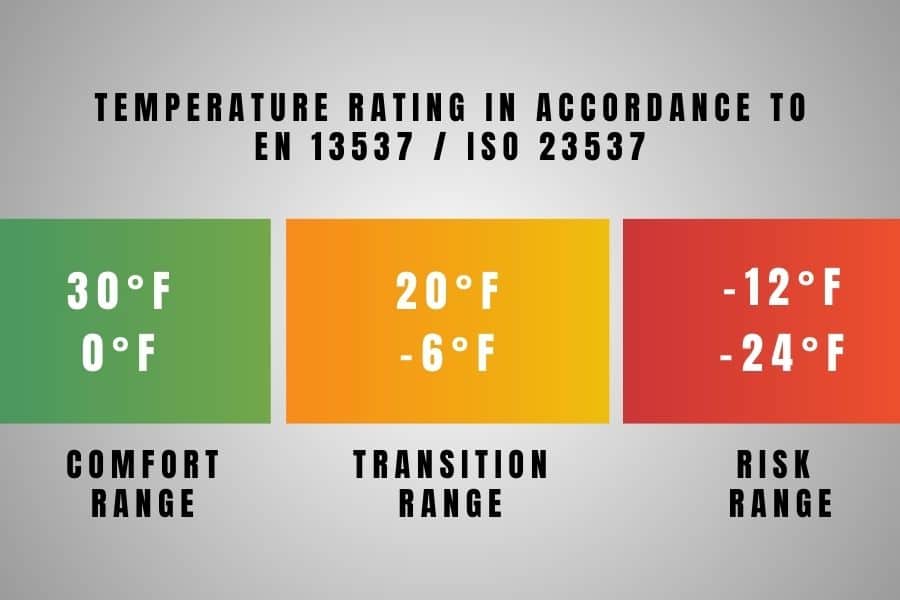
The main difference between the seasonal and EN/ISO systems lies in how the information is advertised to sleeping bag buyers.
The testing process includes putting a heated test dummy in a sleeping bag wearing just base layers and a winter hat.
As the temperature of the surrounding air is gradually lowered, heat sensors measure the warmth retained by the dummy in the sleeping bag.
This test measures the temperature levels that are maintained within the sleeping bag even in the coldest conditions.
Factors Influencing Temperature Ratings
It’s important to take sleeping bag temperature ratings with a grain of salt.
Testing is focused on standardization, so each process is kept exactly the same.
Because of this, the testing process is unable to account for other aspects of a cold night out that might affect your overall warmth in the bag.
Insulation Type: Synthetic Vs. Down
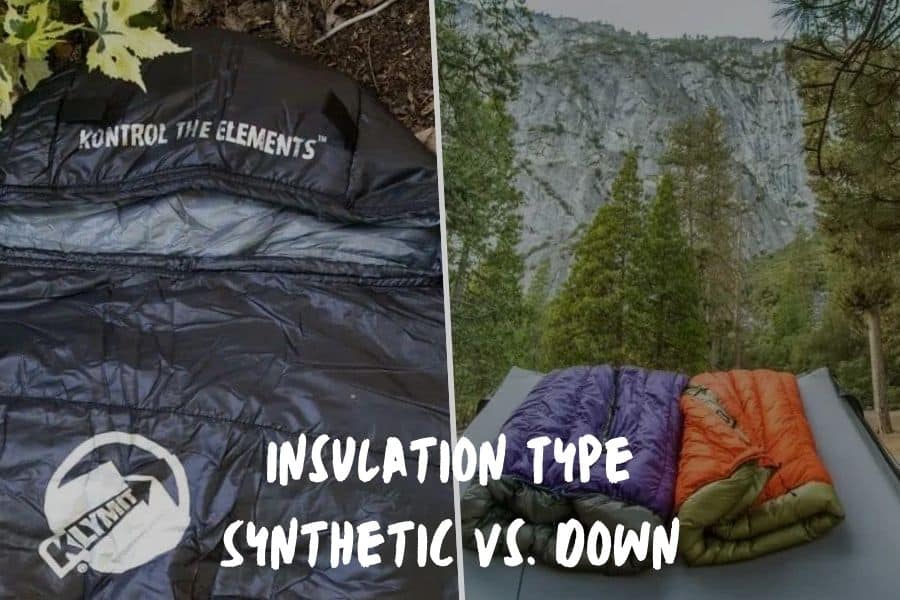
First, your sleeping bag’s temperature capabilities will depend on the type of insulation it uses to keep you warm.
Synthetic insulation materials are less efficient at insulation than down.
Down, even though it sometimes brings a heftier price, is guaranteed to keep you warm and toasty.
Sleeping Bag Shape & Design
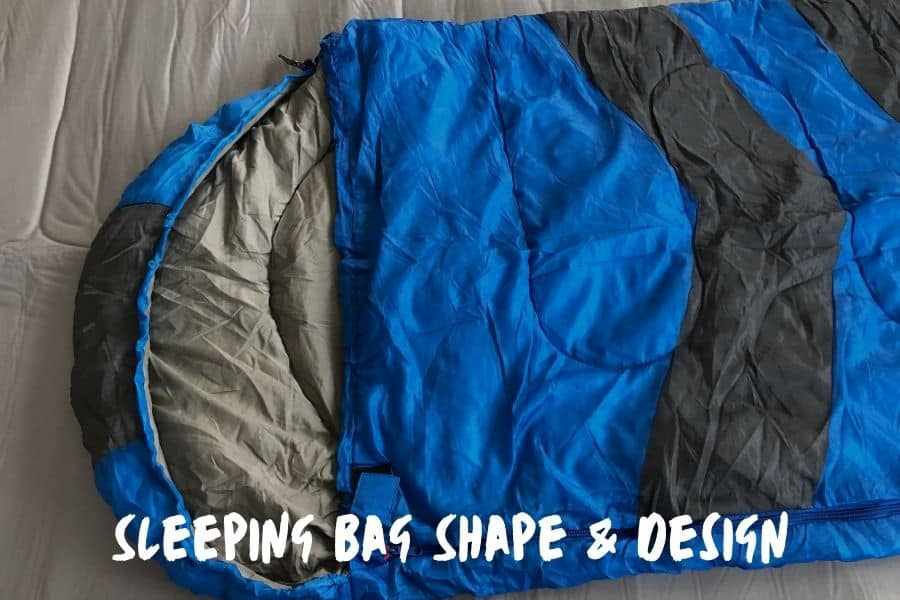
The design of your bag, specifically how it’s designed around your head, can be a factor in how warm it keeps you.
Mummy sleeping bags are going to keep you much warmer because they enclose your shoulders and head with insulation.
And they give the warm air from the interior of your sleeping bag less space to escape.
Your head is a really important factor in keeping warm. If it’s exposed, it affects how cold the rest of your body feels.
Keeping your head, neck, and shoulders surrounded by insulation will work wonders in keeping the rest of your body warm.
The other common design shape for sleeping bags is the classic rectangular shape.
Because this design generally cuts off at your chest and shoulder area, it leaves your neck and head exposed to cold air.
This design has a larger hole at the top of the bag, meaning that warm air is easily able to escape from the interior of the bag, leaving you feeling chilly.
Clothing & Sleeping Pads
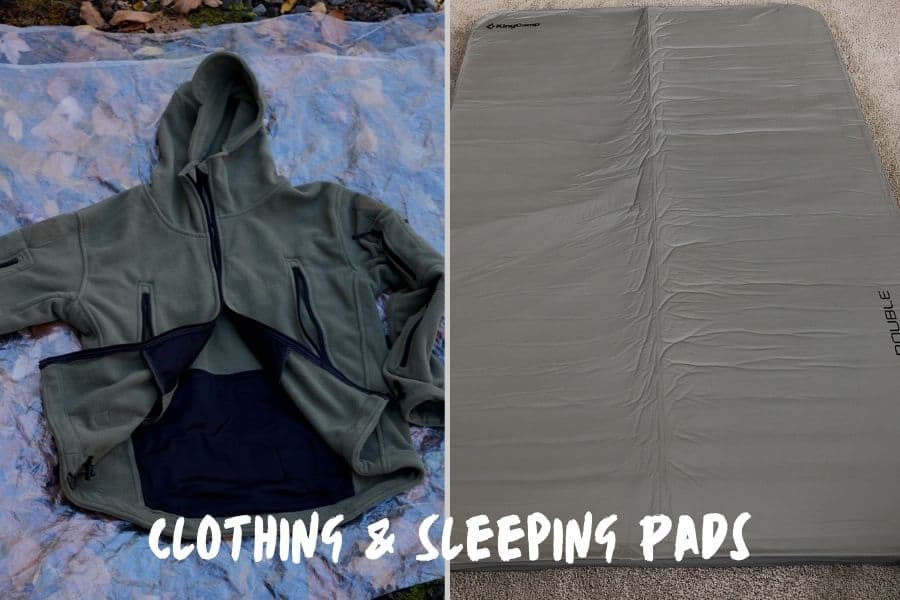
Clothing can really change the game when it comes to staying warm in your bag on a cold night.
Your sleeping bag uses your body heat to warm itself (and you) up, so wearing a few extra layers can be helpful in keeping that temperature nice and toasty.
If you find you need extra layers on a cold night, wearing a down jacket, dry socks, thin gloves, and a hat will help keep you warm in your bag.
Sleeping pads can also contribute to your warmth.
They have their own temperature rating, which signifies the insulation between the ground and your body.
If you don’t plan to use one, then no worries.
If you are planning to use a sleeping pad, then make sure to take its separate r-value temperature rating into account.
How To Choose A Sleeping Bag Based On Temperature Ratings
Assess Your Camping Conditions
You can’t pick out your sleeping bag’s temperature rating unless you know what conditions you will be camping in.
To figure out how cold your camping conditions will be, it’s important to take multiple factors into account.
Weather

For obvious reasons, wintery or snowy conditions will be much colder than balmy summer weather.
Packing a sleeping bag that you know will keep you warm is absolutely crucial for winter camping.
You could even need a different rating than you expected in conditions where you are exposed to cold for an extended period of time.
Location

Location also affects temperature. Things like a nearby body of water or potential wind chill can affect your warmth.
In addition, some areas also have high-temperature variations between night and day (like deserts).
Even though the days can be extremely warm, the temperature can still drop dramatically at night.
Unless the cold conditions are severe, a 3-season bag will keep you warm in most of these scenarios.
Altitude

Lastly, altitude can really affect how warm or cold an area gets, too.
The rule of thumb to keep in mind here is the higher the altitude, the lower the temperature.
Depending on how high your elevation level is, your bag can range anywhere from a 3- to 5-season bag.
Understand Your Personal Comfort Range
Science tells us that some bodies sleep warmer than others, specifically bodies with more muscle mass than fat mass.
Because of this, men sometimes find they can maintain their own heat more efficiently than women.
We also lose muscle mass as we age, so older campers will have a harder time staying warm than their younger counterparts.
When shopping for a sleeping bag, it’s important to take these considerations into account to get a sleeping bag that will be sure to keep you warm.
- Buy an EN/ISO Comfort bag if you sleep colder, have less muscle mass, or are a woman.
- Buy an EN/ISO Limit bag if you sleep warmer, have more muscle mass, or are a man.
The Role Of Versatility: Layering & Overbagging
In especially cold conditions, you can use extra layers to enhance your sleeping bags warmth capabilities. Namely, sleeping bag liners and overbags.
Sleeping bag liners go on the inside of your bag, adding an additional layer of warmth for the bag’s occupant by around 12°C.
Depending on the material, liners are fairly lightweight and can be used in a bag to add warmth or on their own in hotter climates.
Overbags are an additional insulation layer you add to the outside of your bag.
Most overbags are designed to add at least 14°C to your bag’s original temperature capacity.
In cold conditions, these extra layers can be exactly what you need to stay warm.
FAQs
Do Sleeping Bag Liners Improve The Temperature Rating?
Yes, depending on the material it’s made out of, sleeping bag liners can improve your bag’s temperature rating by about 12°C.
How Accurate Are Sleeping Bag Temperature Ratings?
Ratings are generally pretty accurate and consistent to the testing environment they were created in.
However, there is some variation between brands that comes from factors outside of the testing environment’s control.
How Should I Care For My Sleeping Bag To Maintain Its Temperature Rating?
Keeping your sleeping bag in good shape is an important factor in maintaining its temperature rating.
So, when you get home make sure that your sleeping bag is clean and completely dry before loosely folding up in a cool, dry place.
However, even the best maintained bags will lose their insulation capacities over time through basic use.
What Does A Survival Rating On A Sleeping Bag Mean?
Most sleeping bags will come with two main categories of rating: comfort and limit/survival.
Comfort ratings show how cold your conditions can be before you get too chilly for comfort.
But the lower limit measures how cold your conditions can get before you reach hypothermia.
When you’re camping in cold conditions, it’s important to buy your bag according to the comfort category, rather than the lower limit category.
This is to ensure that you have the tools to maintain a safe level of warmth throughout your adventure.
Should I Buy A Sleeping Bag Based On The Lowest Temperature I Plan To Encounter?
I recommend buying a sleeping bag with a rating that’s lower than the lowest temperature you plan to encounter.
You never know what temperatures you’ll run into out there, so it’s important to be prepared.
And, if you ever get too warm, it’s easy to unzip part of your sleeping bag to cool off.
It’s much more difficult to get a sleeping bag warmer than it is to cool off.
Final Thoughts On Sleeping Bag Temperature Ratings
Choosing the right sleeping bag temperature rating for you can make or break your outdoor adventure.
When you’re in the market for a sleeping bag, make sure you pay attention to temperature ratings.
That way, you can pick the bag that will fit your needs the best – and keep you warm!
Also Read


